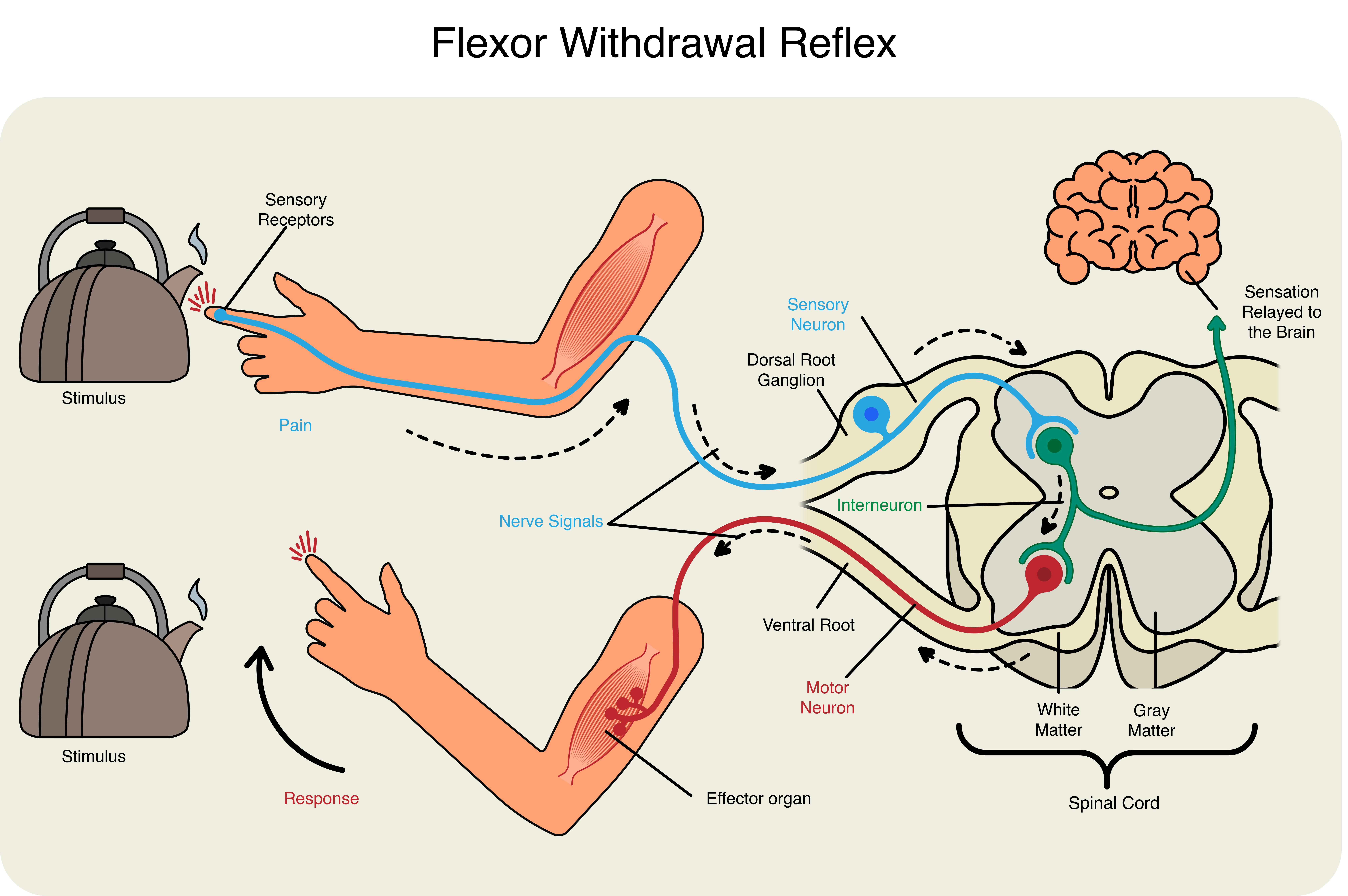Learning Objectives
By the end of this section, you will be able to:
- Describe several reflex arcs and their functional roles
Ventral Horn Output
The somatic nervous system provides output strictly to skeletal muscles. The lower motor neurons, which are responsible for the contraction of these muscles, are found in the ventral horn of the spinal cord. These large, multipolar neurons have a corona of dendrites surrounding the cell body and an axon that extends out of the ventral horn. This axon travels through the ventral nerve root to join the emerging spinal nerve. The axon is relatively long because it needs to reach muscles in the periphery of the body. The diameters of cell bodies may be on the order of hundreds of micrometers to support the long axon; some axons are a meter in length, such as the lumbar motor neurons that innervate muscles in the first digits of the feet.
The axons will also branch to innervate multiple muscle fibers. Together, the motor neuron and all the muscle fibers that it controls make up a motor unit. Motor units vary in size. Some may contain up to 1000 muscle fibers, such as in the quadriceps, or they may only have 10 fibers, such as in an extraocular muscle. The number of muscle fibers that are part of a motor unit corresponds to the precision of control of that muscle. Also, muscles that have finer motor control have more motor units connecting to them, and this requires a larger topographical field in the primary motor cortex of the brain, which contains the upper motor neurons.
Motor neuron axons connect to muscle fibers at a neuromuscular junction. This is a specialized synaptic structure at which multiple axon terminals synapse with the muscle fiber sarcolemma. The synaptic end bulbs of the motor neurons secrete acetylcholine, which binds to receptors on the sarcolemma. The binding of acetylcholine opens ligand-gated ion channels, increasing the movement of cations across the sarcolemma. This depolarizes the sarcolemma, initiating muscle contraction. While other synapses result in graded potentials that must reach a threshold in the postsynaptic target, activity at the neuromuscular junction reliably leads to muscle fiber contraction with every nerve impulse received from a motor neuron. However, the strength of contraction and the number of fibers that contract can be affected by the frequency of the motor neuron impulses.
Reflexes
Reflexes can be spinal or cranial, depending on the nerves and central components that are involved. The body uses both spinal and cranial reflexes to rapidly respond to important stimuli. All reflex arcs include five basic components; (1) a receptor, (2) a sensory neuron, (3) an integration center, (4) a motor neuron, and (5) an effector. The effector may be a skeletal muscle, as is the case in somatic reflexes. However, in autonomic (or visceral) reflexes, the effector will be cardiac muscle, smooth muscle, or a gland.
Somatic spinal reflexes utilize motor neurons of the ventral horn to activate skeletal muscles. The simplest example of this type of reflex is the stretch reflex. In this reflex, when a skeletal muscle is stretched, a muscle spindle receptor is activated. The sensory neuron associated with the muscle spindle synapses directly with the motor neuron in the ventral horn, allowing for an incredibly fast response called a monosynaptic reflex. The reflex helps to maintain muscles at a constant length, and is the reason your head jerks back up after drooping when you begin to fall asleep sitting up. Another common example of this reflex is the knee jerk that is elicited by a rubber hammer struck against the patellar ligament in a physical exam.
Figure 13.5.1 – Stretch Reflex
A different somatic spinal nerve reflex involves the response to pain, like when you touch a hot stove and in response withdrawal your arm, typically before you have even registered the pain in your hand. This reflex is called the flexor withdrawal reflex, and it stimulates the withdrawal of the arm through a connection in the spinal cord that leads to contraction of the biceps brachii. Unlike the stretch reflex, the flexor withdrawal reflex is polysynaptic and requires 2 spinal cord synapses to activate the motor neuron. As you withdraw your hand from the stove, you do not want to slow that reflex down. As the biceps brachii contracts, the antagonistic triceps brachii that had been activated to extend the arm toward the stove now needs to relax. Because the neuromuscular junction is strictly excitatory, the biceps will contract when the motor nerve is active. Skeletal muscles do not actively relax. Instead the motor neuron needs to “quiet down,” or be inhibited. In the hot-stove withdrawal reflex, this occurs through an interneuron in the spinal cord. The interneuron’s cell body is located in the dorsal horn of the spinal cord. The interneuron receives a synapse from the axon of the sensory neuron that detects that the hand is being burned. In response to this stimulation from the sensory neuron, the interneuron then inhibits the motor neuron that controls the triceps brachii, in what is known as reciprocal inhibition. This is done by releasing a neurotransmitter or other signal that hyperpolarizes the motor neuron connected to the triceps brachii, making it less likely to initiate an action potential. With this motor neuron being inhibited, the triceps brachii relaxes. Without the antagonistic contraction, withdrawal from the hot stove is faster and keeps further tissue damage from occurring.

The flexor withdrawal reflex is also at play when you step on a painful stimulus, like a tack or a child’s Lego®. The nociceptors that are activated by the painful stimulus activate the motor neurons responsible for contraction of the tibialis anterior muscle. This causes dorsiflexion of the foot. An inhibitory interneuron, activated by a collateral branch of the nociceptor fiber, will inhibit the motor neurons of the gastrocnemius and soleus muscles to cancel plantar flexion. An important difference in this reflex is that plantar flexion is most likely in progress as the foot is pressing down onto the tack. Contraction of the tibialis anterior is not the most important aspect of the reflex, as continuation of plantar flexion will result in further damage from stepping onto the tack. While all this is happening in one lower limb, a contralateral response will be stimulated to help you catch your balance with the other. This is called the crossed extensor reflex.
In the cross extensor reflex, the same painful stimulus that initiates the flexor withdrawal reflex simultaneously initiates extension of the opposite limb. In the case of stepping on a painful object and pulling your foot away, the cross extensor reflex activated the contralateral quads and gastrocnemius and soleus to extend the leg while plantar flexing the ankle to shift body weight.
All of the somatic spinal nerve reflexes involved so far involve reciprocal inhibition. In each case, a prime mover is stimulated and its antagonist is inhibited. However, in the golgi tendon reflex, the prime mover is inhibited its antagonist is stimulated. This is termed reciprocal activation. In the tendon reflex, prolonged or particularly forceful stretching of the muscle and its tendon trigger the relaxation of the muscle to prevent tearing through the activation of a special receptor, the golgi tendon organ. At the same time, the antagonist muscles is activated to help return the affected muscle and its tendon to their resting lengths.
Figure 13.5.3 – Golgi Tendon Reflex
Cranial nerve somatic reflexes function similarly, but are integrated in the brainstem. A specialized cranial nerve reflex which protects the surface of the eye is the corneal reflex, or the eye blink reflex. When the cornea is stimulated by a tactile stimulus, or even by bright light in a related reflex, blinking is initiated. The sensory component travels through the trigeminal nerve, which carries somatosensory information from the face, or through the optic nerve, if the stimulus is bright light. The motor response travels through the facial nerve and innervates the orbicularis oculi on the same side. This reflex is commonly tested during a physical exam using an air puff or a gentle touch of a cotton-tipped applicator.
External Website

Watch this video to learn more about the reflex arc of the corneal reflex. When the right cornea senses a tactile stimulus, what happens to the left eye? Explain your answer.
External Website

Watch this video to learn more about newborn reflexes. Newborns have a set of reflexes that are expected to have been crucial to survival before the modern age. These reflexes disappear as the baby grows, as some of them may be unnecessary as they age. The video demonstrates a reflex called the Babinski reflex, in which the foot flexes dorsally and the toes splay out when the sole of the foot is lightly scratched. This is normal for newborns, but it is a sign of reduced myelination of the spinal tract in adults. Why would this reflex be a problem for an adult?
Chapter Review
Reflexes are the simplest circuits within the somatic nervous system. A withdrawal reflex from a painful stimulus only requires the sensory fiber that enters the spinal cord and the motor neuron that projects to a muscle. Antagonist and postural muscles can be coordinated with the withdrawal, making the connections more complex. The simple, single neuronal connection is the basis of somatic reflexes. The corneal reflex is contraction of the orbicularis oculi muscle to blink the eyelid when something touches the surface of the eye. Stretch reflexes maintain a constant length of muscles by causing a contraction of a muscle to compensate for a stretch that can be sensed by a specialized receptor called a muscle spindle.
Review Questions
Critical Thinking Questions
- If a reflex is a limited circuit within the somatic system, why do physical and neurological exams include them to test the health of an individual?
Glossary
- corneal reflex
- protective response to stimulation of the cornea causing contraction of the orbicularis oculi muscle resulting in blinking of the eye
- crossed extensor reflex
- an innate, polysynaptic, intersegmental reflex arc; in association with withdrawal reflex, activation of contralateral limb muscles enables the other side of the body to respond, often to maintain balance
- flexor withdrawal reflex
- an innate, polysynaptic reflex; nociceptor activation triggers ipsilateral muscle activation to immediately withdraw from painful stimulus
- golgi tendon reflex
- an innate, polysynaptic reflex; tendon stretch causes the muscle pulling the tendon to relax (ipsilateral)
- golgi tendon organ
- located in tendon; the specific sensory receptors responsible for providing information about tendon length or the rate of change of the length; a mechanoreceptor & proprioceptor; involved in tendon reflex
- muscle spindle
- located in muscle; the specific sensory receptors responsible for providing information about muscle length or the rate of change of the length; a mechanoreceptor & proprioceptor; involved in stretch reflex
- integration center
- the site of communication between sensory and motor neurons
- monosynaptic reflex
- a reflex arc in which the sensory neuron synapses directly with the motor neuron (does not involve an interneuron)
- polysynaptic reflex
- a reflex that uses one or more interneuron and involves more than one synapse between the sensory neuron and motor neuron
- reciprocal activation
- when the primary response of a reflex inhibits a muscle, reciprocal activation refers to activation of the antagonist muscle which occurs synchronously to the primary inhibition
- reciprocal inhibition
- when the primary response of a reflex activates a muscle, reciprocal inhibition refers to inhibition of the antagonist muscle which occurs synchronously to the primary activation
- reflex
- fast, automatic responses to stimuli that send information over a specific neural pathway
- stretch reflex
- response to activation of the muscle spindle stretch receptor that causes contraction of the muscle to maintain a constant length
This work, Anatomy & Physiology, is adapted from Anatomy & Physiology by OpenStax, licensed under CC BY. This edition, with revised content and artwork, is licensed under CC BY-SA except where otherwise noted.
Images, from Anatomy & Physiology by OpenStax, are licensed under CC BY except where otherwise noted.
Access the original for free at https://openstax.org/books/anatomy-and-physiology/pages/1-introduction.

